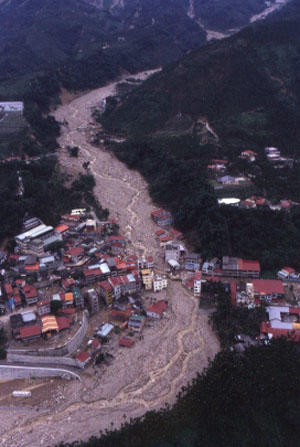Slope Processes 2
Debris flow can be devastated to human life and property, Xin-Yi, Taiwan
Image Credit: S. C. Chang, 2006
The changes in rainfall can also affect the processes of mass movements. Torrential rains can trigger mass movements which occur rapidly under the force of gravity, particularly on steep slopes. Mass movements are slope processes that involve a transfer of slope forming materials under the influence of gravity and are likely to be triggered in conditions of increasing precipitation. There is no transport within a fluid medium such as ice or water, it is the gravity. These include soil creep, landslides, mudflows, debris flows, debris avalanches, earthflows, debris slides, rock slides, slumps and rockfalls. Mass movements can be classified on the basis of the nature of material, the rates of movement, the type of movement/scale and the resulting landform. This leads to three types of movements namely: slides, flow and heaves which can be wet or dry, and fast or slow.
Indeed climate change can have various effects on the rate of mass movements, depending on whether there is an increase or decrease of rainfall. Increasing rainfall is likely to lead to more intense movements, such as avalanches, landslides and mudflows. Climate change can have various effects on the rate of mass movements, depending on whether there is an increase or decrease of rainfall. Increasing rainfall is likely to lead to more intense movements, such as avalanches, landslides and mudflows. The other effects of the slope instability are subsidence or the surface, reactivation of fossil instabilities and flooding.
 Stop and Think!
Stop and Think!
What are the effects of debris flow on the human activities and the landscape? How can we mitigate the hazard shown in the picture on the right side?
